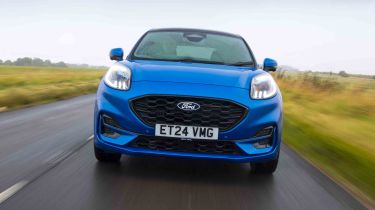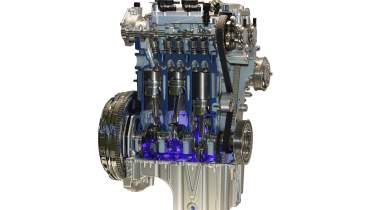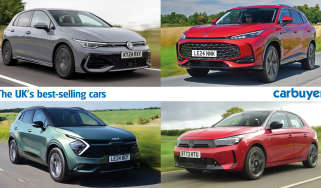Ford EcoBoost engines: reliability, problems and should you buy one?
We cover the pros and cons of Ford’s Ecoboost petrol engines, plus any reliability issues to watch out for

Ford EcoBoost is the name given to a series of petrol engines used across Ford’s lineup, from small superminis up to sports cars and big SUVs. EcoBoost engines make use of turbocharging and direct injection technology to achieve nippy performance and fuel-sipping efficiency, giving buyers the best of both worlds and launching some Fords to best-selling status in the UK.
In this guide, we’ll cover the basics of the EcoBoost, including how it uses turbocharging and direct injection to improve performance and efficiency. We’ll also touch on any reliability concerns surrounding EcoBoost, as well as previous recalls, to help you decide whether a Ford should be your next new or used car purchase.
What is Ford EcoBoost?
The Ford EcoBoost isn’t one engine – rather, it’s the name given to a series of petrol engines used throughout the Ford lineup. The name was introduced in 2010, and it has since appeared on everything from the Ford Fiesta hatchback to the Le Mans-winning Ford GT racecar. While the engines in those two vehicles are certainly very different, they both use turbocharging and direct fuel injection systems.

There are several EcoBoost engines found in Fords today, ranging from a puny 1.0-litre three cylinder, up to a 3.0-litre V6. Many today make use of mild hybrid technology to improve efficiency further, although there are currently no EcoBoost engines paired with self-charging hybrid or plug-in hybrid systems.
The Ford EcoBoost is not to be confused with the Ford EcoBlue engine, which is the brand’s range of turbocharged diesel engines.
Is the Ford EcoBoost reliable?
Generally speaking, the EcoBoost range of engines have proven to be fairly reliable. The first three-cylinder 1.0-litre EcoBoost engine hit the road in 2012 under the bonnet of the Ford Focus. This means the carmaker has had years to refine the technology, which has now been fitted to millions of cars. It’s pretty mainstream technology at this point, which means it’s well run-in – there’s certainly no reason to fear undue breakdown or reliability issues.
As with most mainstream engines, EcoBoost engines should easily clock 80,000-100,000 miles with little need for repair, so long as the vehicle is regularly and properly serviced. In fact, take a quick look through the second hand classifieds and you’ll find many examples of EcoBoost-powered Fords that have racked up in excess of 150,000 miles. As with any car, regular servicing and maintenance will help to prevent engine issues down the line.
It’s worth noting that Ford trailed in 30th place out of 32 brands in the most recent Driver Power owner’s survey. Owners weren’t impressed by the reliability of their Ford, but this takes into account all Ford models, not just ones fitted with an EcoBoost engine.
Are there any known Ford EcoBoost problems?
EcoBoost engines have suffered some issues since their introduction over a decade ago, but many of these problems have since been fixed through recalls and updates.
Early examples of the 1.0-litre three-cylinder were prone to head gasket leaks and even complete engine failure. However, the design faults that led to these problems were quickly addressed, with many of the cars affected receiving repairs and improved parts under warranty – so if an older example hasn’t failed due to a manufacturing problem by now, then it’s probably unlikely to. Either way, it’s still something to be wary of when shopping on the used market.
There were a couple of recalls in 2018, but the faults were not specifically related to the EcoBoost tech. A Focus 1.0-litre EcoBoost recall referred to a nylon pipe potentially overheating in the cooling system, while a potentially more serious fault in the cylinder head of 1.6-litre EcoBoost engines again isn’t directly related to EcoBoost tech.
Ford EcoBoost ‘wet belt’ problem
Perhaps the biggest cause of concern was a major recall in North America in 2024, relating to the EcoBoost ‘wet belt’ system. More than 130,000 Ford Focus and Ford EcoSport vehicles with the 1.0-litre EcoBoost and automatic gearbox were recalled relating to an issue with the belt driving the oil pump, known as the wet belt.

The same engine and gearbox setup was offered in the Focus, EcoSport and Fiesta in the UK. While there have been several reports of issues with this engine and gearbox combination in the UK, Ford has not announced a recall here as of yet.
What are the benefits of Ford EcoBoost?
Ford likes to explain EcoBoost by splitting the name into its two constituent parts. ‘Eco’ refers to the engine’s fuel economy and reduction in CO2 emissions, while ‘Boost’ refers to the unit’s power and performance potential. The two qualities are combined into a single engine package that offers both efficiency and eager acceleration. Ford has achieved this by using two specific technologies.
Delivering the first part of the equation – improved economy – is the direct fuel injection system that dispenses with a traditional intake manifold and sprays a precisely measured and shaped jet of petrol into each cylinder at exactly the right moment in the combustion cycle. With extremely efficient combustion, it’s possible to reduce the amount of fuel required in any driving cycle, giving EcoBoost-equipped cars the potential to return impressive economy figures. As an example, the Ford Kuga family SUV can return up to 44mpg in a mixture of driving conditions from its 1.5-litre EcoBoost engine.

But drivers want flexibility and performance too, and it’s turbochargers that put the boost into EcoBoost engines. These increase the performance levels to the point where a 1.0-litre EcoBoost engine can not only reproduce the driving characteristic of a larger 1.6-litre, but actually improve on them. That’s because fitting a turbocharger means more torque – or pulling power – is available throughout the rev range, which makes an EcoBoost car feel nipper in everyday driving. Read our full explainer on turbochargers to understand how forced induction makes an engine more powerful.
It’s worth bearing in mind that while the EcoBoost name is unique to Ford, the technology that underpins it is not bespoke. In fact, the combination of direct injection and turbocharging that allows these engines to combine strong performance and economy is similar to that used in many of the Blue Oval’s rivals, such as Volkswagen’s TSI (Turbo Stratified Injection) units.
One potential issue facing buyers looking to make the switch to an EcoBoost car is that the quoted fuel economy figures in the real world can vary. The turbocharger on an EcoBoost engine delivers punchy performance and if you’re tempted to use that performance often, the fuel economy advantages will start to disappear.
Should you buy a Ford EcoBoost model?
If you’re looking for a well-rounded petrol car, then a Ford EcoBoost model is certainly worth considering. Their balance of performance and economy has made them some of the most popular cars in the UK, and the introduction of mild hybrid technology has only bolstered their appeal.
Which Ford models offer EcoBoost engines?
Practically every Ford model from the past decade has been offered with an EcoBoost engine, and the same remains true for the brand’s current lineup – electric models aside.
Ford’s best-selling small SUV – the Puma – exclusively uses EcoBoost engines, with the 1.0-litre unit capable of up to around 50mpg in a mixture of town and motorway driving. Throughout the Ford range, this engine is by far and away the most popular, striking what seems to be the optimum balance between efficiency and performance for most UK buyers.
Ford's hot hatchback line-up is also powered by EcoBoost petrol engines, with a turbocharged 1.5-litre three-cylinder EcoBoost engine powering the Puma ST, while the larger Focus ST is powered by a 2.3-litre EcoBoost engine.
On our shores, the most powerful EcoBoost engine currently on sale is the 288bhp 3.0-litre V6 that’s found in the nose of the Ford Ranger Raptor pick-up truck. Yet even this seems mild compared to the 647bhp 3.5-litre V6 EcoBoost that was used in the Ford GT, which was effectively a thinly disguised Le Mans racer for the road.
Ford EcoBoost mild-hybrid
Today, the Ford Puma and Ford Focus can only be ordered with an EcoBoost engine with a mild hybrid system – other than the high-performance Focus ST.
Based on the 1.0-litre petrol engine, it uses a belt-driven starter-generator system that harvests energy normally lost during braking and coasting (known as regenerative braking) into a small battery. This recuperated energy is then used to improve the efficiency of the stop-start system and provides a small boost in power to help take the strain off the petrol engine during normal driving and under acceleration. The result is improvements in fuel economy, emissions and performance.
Alongside a mild hybrid model, Ford now also offers the Kuga SUV with either a self-charging hybrid or plug-in hybrid engine, although this is branded as Duratec, not EcoBoost. These systems work differently from a mild hybrid setup, so read our explainers to find out which is the right model for you.
Want to know how the EcoBoost engine compares to its rivals? Read our list of the most economical cars on sale…
Recommended

Petrol and diesel car ban relaxed with hybrids permitted beyond 2030

In-car safety assistance systems leaving drivers confused and dissatisfied
Most Popular
Tips & advice

Car dashboard warning lights: what does each symbol mean?

Electric car charging stations: public networks, charger types, apps and maps







